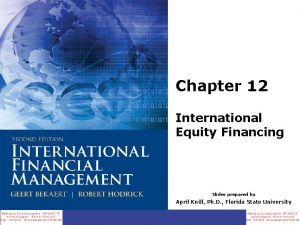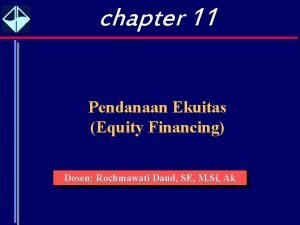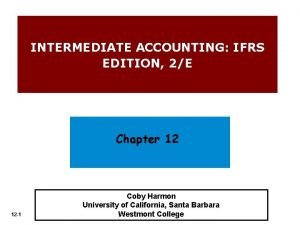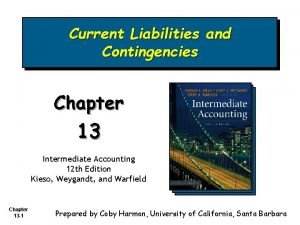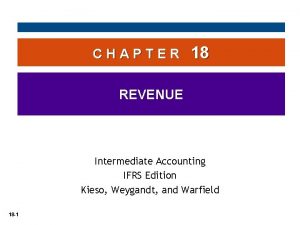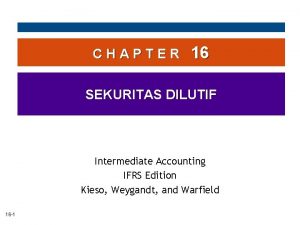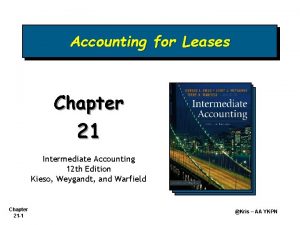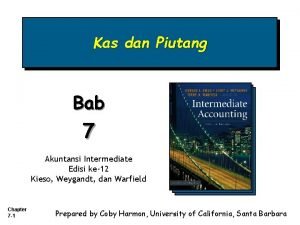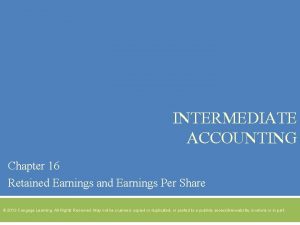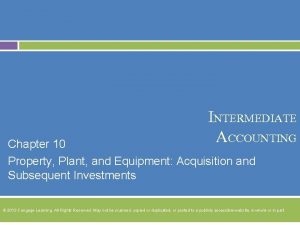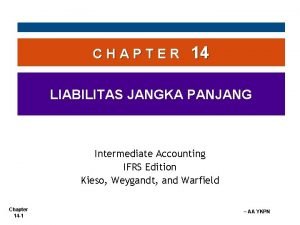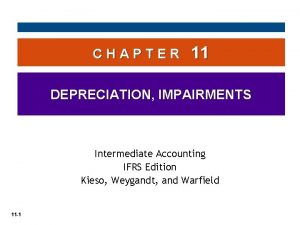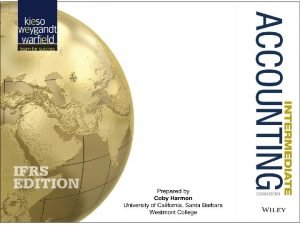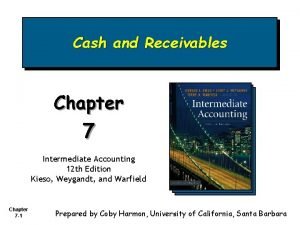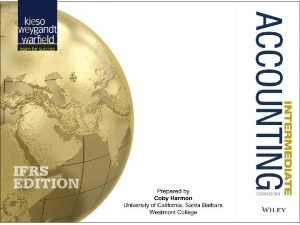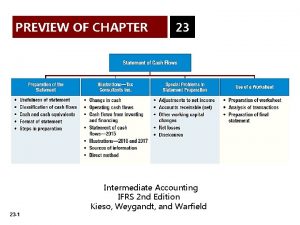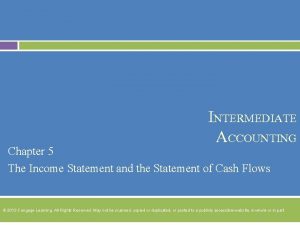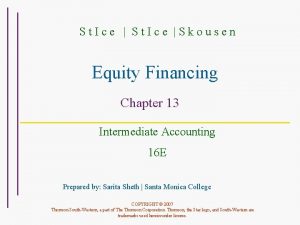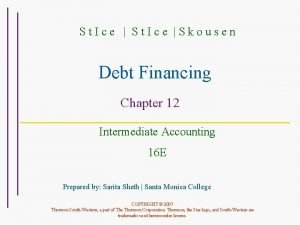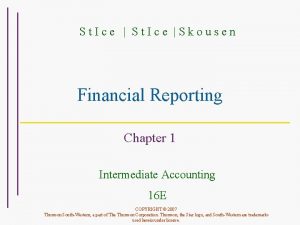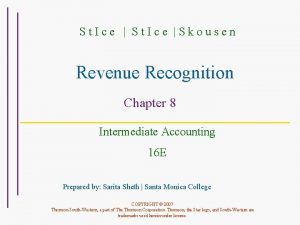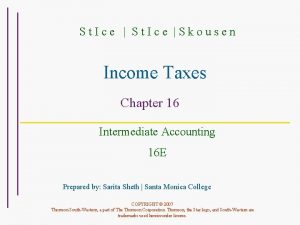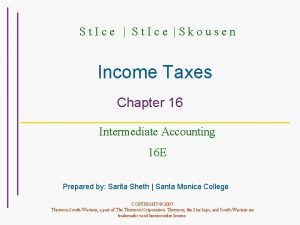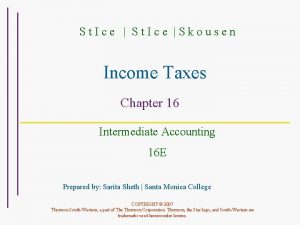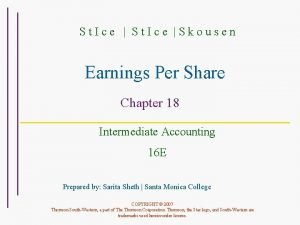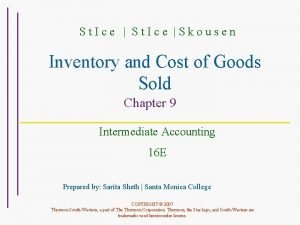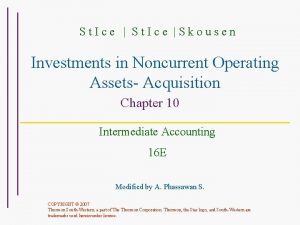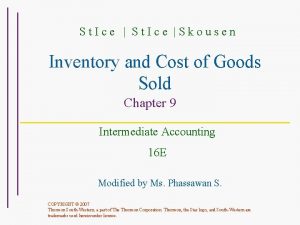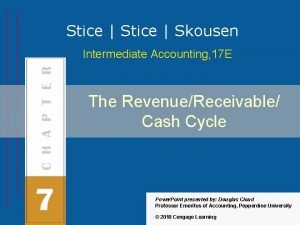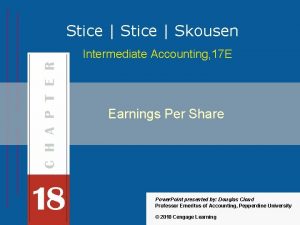St Ice Skousen Equity Financing Chapter 13 Intermediate




























- Slides: 28

St. Ice |Skousen Equity Financing Chapter 13 Intermediate Accounting 16 E Prepared by: Sarita Sheth | Santa Monica College COPYRIGHT © 2007 Thomson South-Western, a part of The Thomson Corporation. Thomson, the Star logo, and South-Western are trademarks used herein under license.

Learning Objectives 1. Identify the rights associated with ownership of common and referred stock. 2. Record the issuance of stock for cash, on a subscription basis, and in exchange for non-cash assets or for services. 3. Use both the cost and par value methods to account for stock repurchases. 4. Account for the issuance of stock rights and warrants.

Learning Objectives 5. Compute the compensation expense associated with the granting of employee stock options. 6. Determine which equity-related items should be reported in the balance sheet as liabilities. 7. Distinguish between stock conversions that require a reduction in retained earnings and those that do not. 8. List the factors that impact the Retained Earnings balance.

Learning Objectives 9. Properly record cash dividends, property dividends, and stock splits. 10. Explain the background of unrealized gains and losses recorded as part of accumulated other comprehensive income, and list the major types of equity reserves found in foreign balance sheets. 11. Prepare a statement of changes in stockholders’ equity.

Nature and Classifications of Paid-In Capital • A corporation is a legal artificial entity separate from its owners. • Individuals contribute capital for which the corporation issues certificates making them stockholders. • The board of directors are elected by the stockholders and they are in charge of overseeing the long run plan for the organization.

Common Stock • • Common Stock (CS)- when a corporation is formed, the single class of stock typically issued. Owners of common stock have these basic rights: 1. To vote in the election of directors and in the determination of certain corporate policies. 2. Preemptive right- to maintain one’s proportional inerest in the corporation through purchase of additional common stock if and when it is issued.

Par or Stated Value • Par Value- historically was equal to the market value of the shares at issuance. • Today, most stocks have a nominal par value or no par value. • Stated value- stocks with no-par that for financial reporting purposes acts like a par value.

Preferred Stock • Rights given up by preferred stockholders (PS): 1. Voting- in most PS are not allowed to vote for the board of directors. 2. Sharing in success- Cash dividends received by PS are usually fixed in amount. If the firm does extremely well, their dividend amount is not adjusted.

Preferred Stock • Rights enjoyed by preferred stockholders: 1. Cash dividend preference- PS are entitled to receive their full cash dividend before any cash dividends are paid to CS. 2. Liquidation preference- In the even of bankruptcy, PS are entitled to have their investments repaid before CS.

Issuance of Capital Stock • The issuance of stock for cash is recorded by a debit to Cash and a credit to Capital Stock for the par value. • When the amount of cash received for the stock is more than the par value, the excess is recorded as a credit to additional paid-in capital or paid in capital in excess of par.

Capital Stock Issued for Cash Goode Corporation issued 4, 000 shares of no par common stock without a stated value on April 1, 2006, for $45, 000 cash. Apr. 1 Cash 45, 000 Common Stock 45, 000

Capital Stock sold on Subscription On November 1, 2006, a firm received subscriptions for 5, 000 shares of $1 par common at $12. 50 per share with 50% down, balance due in 60 days Nov. 1 CS Subscription Receivable 62, 500 Common Stock Subscribed 5, 000 Paid-In Capital in Excess of Par 57, 500 Nov. 1 Cash 31, 250 Common Stock Subscription Receivable 31, 250

Capital Stock Sold on Subscription On December 9, received balance due on one-half of subscribers and issued stock to fully paid subscribers, 2, 500 shares. Dec. 9 Cash 15, 625 Common Stock Subscription Receivable Dec. 9 Common Stock Subscribed Common Stock 15, 625 2, 500

Capital Stock Issued for Consideration Other than Cash AC Company issues 200 shares of $0. 50 par value common stock in return for land. The company’s stock is currently selling for $50 per share. Dec. 5 Land 10, 000 Common Stock Paid-In Capital in Excess of Par 9, 900 100

Reasons Companies Repurchase Stock 1. Provide shares for incentive compensation and employee savings plans. 2. Obtain shares needed to satisfy requests by holders of convertible securities. 3. Reduce the amount of equity relative to the amount of debt. 4. Invest excess cash temporarily.

Reasons Companies Repurchase Stock (cont. ) 5. Remove some shares from the open market in order to protect against a hostile takeover. 6. Improve per-share earnings by reducing the number of shares outstanding and returning inefficiently used assets to shareholders. 7. Display confidence that the stock is currently undervalued by the market.

Treasury Stock • • Stock issued by a corporation but subsequently reacquired by the corporation and held for possible future reissuance or retirement. Reported as a contra-equity account, not as an asset. Does not create a gain or loss on reacquisition, reissuance, or retirement. May decrease Retained Earnings, but cannot increase it.

Stock Rights, Warrants, and Options • Stock rights- Issued to existing shareholders to permit them to maintain their proportionate ownership interests when new shares are to be issued. • Stock warrants- Sold by the corporation for cash, generally in conjunction with the issuance of another security. • Stock options- Granted to officers or employees, usually as part of a compensation plan.

Stock Warrants Stewart Co. sells 1, 000 shares of $50 par preferred stock for $58 per share. Stewart Co. gives the purchaser detachable warrants enabling the holders to subscribe to 1, 000 shares of $2 par common stock for $25 per share. Immediately following the issuance of the stock, the warrants are selling for $3, and the fair market value of a preferred share without the warrant attached is $57.

Factors Affecting Retained Earnings • Error corrections • Some changes in accounting principle • Net income • Quasi-reorganizations Retained Earnings Increases

Factors Affecting Retained Earnings Decreases • Error corrections • Prior period adjustments • Treasury stock • Net loss • Some changes in accounting principles • Cash and stock dividends Retained Earnings

Accounting for Dividends • Declaration date- The date the corporation’s board of directors formally declares a dividend will be paid. • Date of record- The date on which stockholders of record are identified as those who will receive a dividend. • Date of payment- The date when the dividend is actually distributed to stockholders.

Cash Dividends ABC Corporation declares a $100, 000 dividend; the following journal entries should be made: Declaration Date Dividends (Retained Earnings) Dividends Payable 100, 000 Payment Date Dividends Payable Cash 100, 000

Property Dividends • Property dividends- a distribution to stockholders that is payable in some asset other than cash. Bigler Corporation owns 100, 000 shares in Tri-State Oil Co, carrying value $2, 700, 000, current market value $3, 000, or $30 per share. There are 1, 000 shares of Bigler stock outstanding. A dividend of 1/10 of a share of Tri-State Oil Co. is declared for each share of Bigler stock outstanding.

Property Dividends Declaration of Dividend (or Retained Earnings) Property Dividends Payable Gain on Distribution of Property Dividend 3, 000 Property Dividends Payable Investment in Tri-State Oil Co. 2, 700, 000 Payment of Dividend 300, 000 2, 700, 000

Stock Dividends • Small – Less than 20 -25% of the outstanding shares. – Debit Retained Earnings for the MARKET value of the shares. • Large – Greater than 20 -25% of the shares outstanding. – Debit Retained Earnings for the PAR value of the shares.

Liquidating Dividends • Liquidating dividend- a return to stockholders of a portion of contributed capital. Stubbs Corp declared and paid a cash dividend ($10 cash dividend) totaling $100, 000 and a partial liquidating dividend for $50, 000. Declaration Date Dividends (Retained Earnings) 100, 000 Paid in Capital in Excess of Par 50, 000 Dividends Payable Payment Date Dividends Payable 150, 000 Cash 150, 000

Disclosures Related to the Equity Section • Capital stock may be: – Authorized but unissued. – Subscribed for and held for issuance pending receipt of cash for the full amount of the subscription price. – Outstanding in the hands of stockholders. – Reacquired and held by the corporation for subsequent reissuance. – Canceled by appropriate corporate action.
 Ekuitas saham prioritas 15
Ekuitas saham prioritas 15 International equity financing
International equity financing Pembiayaan ekuitas equity financing
Pembiayaan ekuitas equity financing Icing
Icing Clear ice vs rime ice
Clear ice vs rime ice Chapter 8 financing a business
Chapter 8 financing a business Book value per ordinary share
Book value per ordinary share Intermediate accounting kieso chapter 17 investment
Intermediate accounting kieso chapter 17 investment Amortization expense formula
Amortization expense formula Gain contingencies
Gain contingencies Intermediate accounting chapter 18
Intermediate accounting chapter 18 Intermediate accounting chapter 16
Intermediate accounting chapter 16 Chapter 21 accounting for leases kieso terjemahan
Chapter 21 accounting for leases kieso terjemahan Income tax expense
Income tax expense Bab 7 kas dan piutang kieso
Bab 7 kas dan piutang kieso Intermediate accounting chapter 16
Intermediate accounting chapter 16 Intermediate accounting chapter 10
Intermediate accounting chapter 10 Chapter 2 conceptual framework
Chapter 2 conceptual framework Liabilitas jangka pendek
Liabilitas jangka pendek Kunci jawaban buku intermediate accounting ifrs chapter 11
Kunci jawaban buku intermediate accounting ifrs chapter 11 Chapter 3 intermediate accounting
Chapter 3 intermediate accounting Chapter 15 intermediate accounting
Chapter 15 intermediate accounting Financial accounting chapter 1
Financial accounting chapter 1 Liablities
Liablities Us gaap conceptual framework
Us gaap conceptual framework Trade receivables examples
Trade receivables examples Net realizable value formula
Net realizable value formula Intermediate accounting chapter 23
Intermediate accounting chapter 23 Chapter 5 intermediate accounting
Chapter 5 intermediate accounting

